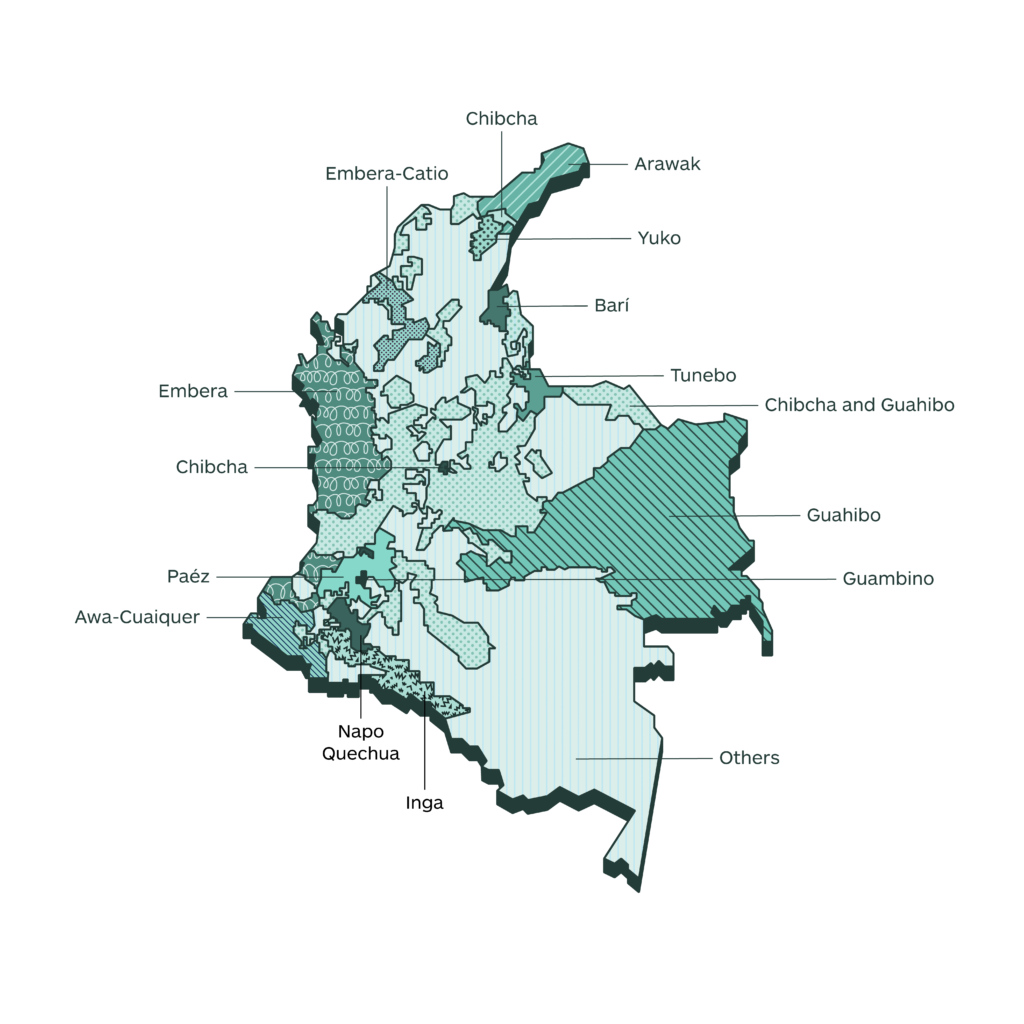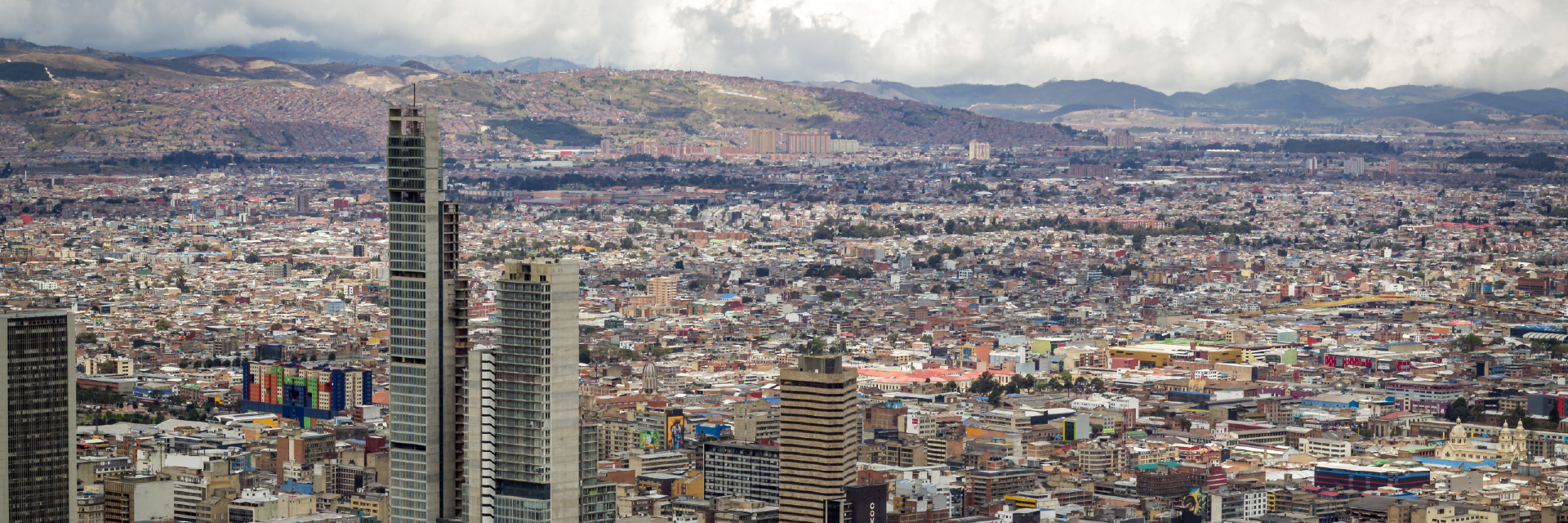South America
To which language should you translate to localize in Colombia?
What we know from our community
English
“We are a magical country, more specifically a magical realism one, as perfectly described by Gabriel Garcia Marquez in his works. A place where reality surpasses fiction. Steeped in culture, diversity, and natural wealth, it is the country with the highest biodiversity per square meter in the world. Spanish is spoken here, as Juanes sings in his songs, but also more than 65 native languages across the territory.
Here, coffee runs through our veins and is enjoyed at breakfast, lunch, birthdays, reunions, and even funerals. But we don’t just have the best coffee; we also have emeralds, roses, birds, butterflies, and orchids.
The land has given us not only resources but also the characteristic joy and humor that we have turned into a universal language. We export joy in the form of soap operas, literature, music, and sports. Here, football goals are not just shouted; they are danced. Here, we laugh at our own difficulties and find the bright side in everything.
Despite being a tropical country, we have all possible climates, so if you visit, a good jacket is essential because Bogotá can be as rainy as London or Brussels.
And remember, it’s Colombia, not Columbia”.Spanish
Somos un pais mágico, del realismo mágico más específicamente, como lo describe perfectamente Gabriel Garcia Marquez en sus obras. Un lugar en donde la realidad supera la ficción. Impregnado de cultura, diversidad y una riqueza natural que lo convierte en el pais con mas biodiversidad por metro cuadrado del mundo. Se habla español como lo dice Juanes en sus canciones, pero también más de 65 lenguas nativas en todo el territorio.
Acá el café nos corre por las venas y se toma en desayunos, almuerzos, cumpleaños, reencuentros y hasta velorios. Pero no solo tenemos el mejor café, también las esmeraldas, rosas, aves, mariposas y orquídeas.
La tierra nos ha dado no solo los recursos sino también esa alegría y humor característicos que hemos convertido en lenguaje universal. Exportamos alegría en forma de novelas, literatura, música y deporte. Acá los goles en fútbol no solo se gritan sino se bailan, acá nos reímos de nuestras propias dificultades y le encontramos el lado amable a todo.
A pesar de ser un país tropical tenemos todos los climas posibles, entonces si nos visitan infaltable una buena chaqueta porque Bogotá puede ser tan lluviosa como Londres o Bruselas.
Y recuerden, es Colombia no Columbia.
LANGUAGE INSIGHT
Official language
Spanish (99%)
Actual languages
Spanish (99%), Arawakan (0.1%), English Creole (0.1%), Quechua (0.1%), other (0.7%)
What the top 150 best localized websites in the world do in Colombia
(Top 150 websites listed in the Global by Design ranking – published annually by Byte Level Research, this report provides a list of globally localized websites, showcasing best practices and emerging trends in their globalization)
- 99/150 localize by translating into Spanish
- 3/150 localize by translating into LatAm Spanish
- 1/150 localizes by translating into LatAm Spanish, French and Simplified Chinese
- 1/150 localizes by translating into Spanish, Kuna Language and Kichwa
- 1/150 localizes by translating into both Spanish and Colombian Sign Language
- 1/150 localizes by translating into Spanish, Portuguese, French, Italian, German, Russian, Turkish, Polish, Romanian, Hungarian, Bahasa Indonesia, Simplified Chinese, Traditional Chinese, Japanese, Thai and Ukrainian
-
3M
-
ABB
-
Accenture
-
Adidas
-
Adobe
-
Airbnb
-
Aldi
-
Amazon
-
American Airlines
-
American Express
-
Apple
-
Audi
-
Autodesk
-
Avis
-
Bayer
-
BMW
-
Booking.com
-
Bosch
-
British Airways
-
Bumble
-
Burberry
-
BYD
-
Canon
-
Capgemini
-
Cartier
-
Caterpillar
-
Chevrolet
-
Cisco Systems
-
Citibank
-
Coca-Cola
-
Costco
-
Dell
-
Deloitte
-
Delta
-
DHL
-
Disney+
-
Dyson
-
eBay
-
Eli Lilly
-
Emirates
-
Ernst & Young
-
Facebook
-
FedEx
-
Ford
-
Four Seasons
-
Fujifilm
-
GE
-
Gillette
-
GoDaddy
-
Google
-
Gucci
-
Haier
-
Heineken
-
Hermès
-
Hertz
-
Hilton
-
Hisense
-
Hitachi
-
Honda
-
Hotels.com
-
HP
-
HP Enterprise
-
HSBC
-
Huawei
-
Hyatt
-
Hyundai
-
IBM
-
IKEA
-
Intel
-
InterContinental Hotels
-
J&J
-
Jack Daniel's
-
Jehovah’s Witnesses
-
John Deere
-
Kellogg's
-
Kia
-
KPMG
-
L'Oréal
-
Land Rover
-
LEGO
-
Lenovo
-
Lexus
-
LG
-
Louis Vuitton
-
Lululemon
-
LUSH
-
Marriott
-
MasterCard
-
McDonald's
-
Mercedes-Benz
-
Merck
-
Microsoft
-
Mitsubishi Electric
-
Nestlé
-
Netflix
-
Nike
-
Nikon
-
Nintendo
-
Nio
-
Nissan
-
NIVEA
-
Oracle
-
Pampers
-
Panasonic
-
PayPal
-
Pepsi
-
Pfizer
-
Philips
-
Pitney Bowes
-
Porsche
-
Procter & Gamble
-
PWC
-
Revolut
-
Rolex
-
Royal Caribbean
-
Salesforce
-
Samsung
-
Sanofi
-
SAP
-
Sephora
-
Shopify
-
Siemens
-
Sony
-
Spotify
-
Starbucks
-
Steelcase
-
Stripe
-
Subaru
-
Tesla
-
The Church of Jesus Christ of Latter-day Saints
-
Tiffany
-
Tinder
-
Toshiba
-
Toyota
-
TripAdvisor
-
Uber
-
United Airlines
-
UPS
-
Visa
-
Volkswagen
-
Volvo Cars
-
Vrbo
-
Walmart
-
Western Union
-
Wikipedia
-
Wise
-
WordPress
-
Workday
-
Xerox
-
Xiaomi (Mi)
-
Zara
-
Zoom
If you need others information, below you can find a selection of economic/social/cultural data
Overview
Language
Official language
Spanish 99.5%
T-index
0.4%
T-Index ranks countries according to their potential for online sales.
Other languages
Arawakan languages, Barbacoan languages, Bora–Witoto languages, Cariban languages, Chibchan languages, Choco languages, Guajiboan languages, Nadahup languages, Quechuan languages, Piaroa–Saliban languages, Tucanoan languages; Andoque, Ticuna, Kamëntsá, Cofán, Páez,
English
Low proficiency (EF) – 75 of 113 countries/regions in the world- 17/20 position in Latin America.
Demography
Capital: Bogotà
Currency: Colombian peso
Population: 51.874 milions
Population density: 46/km2
Economy
GDP: 343.62 billion USD (2022)
GDP per capita: 6,624.2 USD (2022)
Exports: $60.3 billion (2022)
Statistics
Internet users: 75.7% penetration, 39.51 million
Unemployment rate: 14.3% (2024)
Urbanisation: 82.5% (2024)
Literacy: 95.6% (2024)
Conventions
Numbering system
Arabic numerals and comma as decimal separator
Date format: dd – mm – yyyy
Time: 24h time system
Country code: 0057
Language data sources: Worldatlas/Britannica//EF/Wikipedia; Demography data sources: IMF/Worldometers; Conventions data source: Wikipedia; Economy data sources: WTO/OEC/CIA/Esomar/Datareportal; Statistics data sources: Datareportal/WorldBank/UN/UNESCO/CEIC/IMF/Culturalatlas/Commisceoglobal
Facts and data
Economy
Imports
$73.5 billion (2022). Refined Petroleum ($6.26B), Cars ($2.73B), Broadcasting Equipment ($2.64B), Corn ($2.02B), and Packaged Medicaments ($1.77B), importing mostly from United States ($19.4B), China ($18.1B), Brazil ($5.16B), Mexico ($3.6B), and Germany ($2.24B).
Financial inclusion factors (over 15 years of age)
• 45% have an account with a financial institution
• 14% have a credit card
• 4.7% have a mobile money account
• 12% make online purchases
Ease of doing business
Ease of conducting business is medium (rated 70.1 out of 100). Ranked 3rd out of 32 Caribbean and Latin American countries. Ranked 67th out of 190 countries worldwide (2019, World Bank).
Exports
$60.3 billion (2022). Crude Petroleum ($16.1B), Coal Briquettes ($12.9B), Coffee ($4.15B), Refined Petroleum ($2.64B), and Gold ($2.59B), exporting mostly to United States ($15.6B), Panama ($5.84B), Netherlands($3.67B), India ($2.55B), and Brazil ($2.39B).
Main local online stores
mercadolibre.com.co, dafiti.com.co and linio.com.co, asivendo.com.ar and mercadoshops.com.co
Economic freedom
‘Mostly free’ (rated 59.2 out of 100). Ranked 19th out of 32 Latin American countries. Ranked 84h out of 186 countries worldwide (2024, Heritage Foundation and Wall Street Journal).
Global Innovation Index
Ranked 5th out of 18 Latin American and Caribbean countries, 66th out of 132 worldwide.
The Global Innovation Index captures the innovation
ecosystem performance of 132 economies and tracks the most recent global innovation trends.
Economy data sources: WTO/OEC/CIA/Esomar/Datareportal
Service Imports (2020)
Service Exports (2020)
Source: OEC
Trade balance of goods from 2012 to 2022
Source: Statista
Historical Data Trade Imports (2020)
The following section uses historical trade data imports from partners of Colombia.
Historical Data Trade Exports (2020)
The following section uses historical trade data exports from partners of Colombia.
Source: OEC
The Top Export Opportunities for Colombia by Relatedness
Relatedness measures the distance between a country's current exports and each product by showing only products that Colombia is not specialized in.
Colombia's Most Complex Exports
The Product Complexity Index (PCI) measures the knowledge intensity of a product by considering the knowledge intensity of its exporters.
Source: OEC
Colombia's Most Specialized Products
Specialization is measured using Revealed Comparative Advantage (RCA), an index that takes the ratio between Colombia observed and expected exports in each product.
Source: OEC
Perception of products made in selected countries in 2017
Source: Statista
Which attributes do you associate with products made in Colombia?
Source: Statista
Market Growth Imports (2020)
This score represents the likelihood that the given country will start importing that product in the next few years. It forecasts the opening of a new specific market.
Market Growth Exports (2020)
This score represents the likelihood that the given country will start exporting that product in the next few years. It forecasts the opening of a new specific market.
Source: OEC
Foreign direct investment, net inflows (% of GDP)
Source: WorldBank
Most popular payment methods for online shopping in Colombia in 2018
Source: CCCE
B2B e-commerce spending per capita in Colombia in 2011, 2016 and 2021
(in 1,000 Colombian pesos)
Source: Nielsen

T-index
Reach most of the online purchasing power
T-Index ranks countries according to their potential for online sales. It estimates the market share of each country in relation to global e-commerce.
Try it nowMedia
Media language Spanish
Information channels
Colombian journalists have for decades faced intimidation from rebel groups, drug traffickers and paramilitaries.
Coverage of such subjects as the environment, armed conflict, corruption or collusion between politicians and illegal armed groups elicits systematic harassment, intimidation and violence, says Reporters Without Borders (RSF).
Despite this, the media are generally free to express a range of opinions and cover sensitive issues.
There have been an increasing number of attacks against journalists during protests, and trust in the media continues to decline. Media ownership is concentrated among a handful of private groups. TV is the main news source. The print media are privately-owned; El Tiempo is the most widely-read newspaper.
The press
El Tiempo – Liberal Party daily
El Nuevo Siglo – Conservative Party daily
El Colombiano – Medellin-based daily
Vanguardia Liberal – daily
El Espectador – daily
La Republica – business daily
Semana – weekly
Colombia Reports – English-language online news
Television
Senal Colombia – state-run
Telecaribe – private
RCN TV – operated by Radio Cadena Nacional
Caracol TV – private commercial network
Radio
Radio Nacional de Colombia – state-run
Cadena Super – including Radio Super and Super Stereo FM
Caracol – runs several networks, including flagship station Caracol Colombia
Radio Cadena Nacional (RCN Radio) – mediumwave (AM) network with many affiliates
Media data source: BBC
Internet Data
Internet users
75.7% penetration, 39.51 million.
Share of web traffic by device
68.18% mobile phones, 31.09% computers (laptops and desktops), 0.66% tablet devices and 0.06% other devices.
Median download speed of mobile Internet connection
12.26 Mbps
Average speed of fixed Internet connection
111.81 Mbps
Mobile connection as a percentage of total population: 147.5%
Percentage of mobile connections that are broadband (3G-5G): 94.4%
Most popular web search engines
Google (93.7%), Bing (3.93%), Yahoo (2.09%), DuckDuckGo (0.09%), YANDEX (0.08%), Ecosia (0.06%).
Most used social media
Facebook (56.69%), Instagram (22.13%), YouTube (8.89%), Pinterest (8.56%), Twitter (2.27%), LinkedIN (0.23%).
Internet data sources: Datareportal/Statcounter
Devices used for online shopping in Colombia in 2018, by age
Source: TheCocktailAnalisys
Most popular internet browsers in Colombia in 2019 by market share
Social statistics
Life expectancy
74 yrs (2022).
Healthcare expenditure
9.02% of GDP (2021).
Education expenditure
86.8% of total expenditure in public institutions (2021).
Co2 emissions
1.6 metric tons per capita (2020)
Gender
Colombia is increasingly equalitarian with regard to the gender issue; however, women are not well perceived in some types of jobs. It is common these days to see women in high-ranking corporate positions and gender is not an issue at all if their level of education is comparable to that of her colleagues. In the lower income classes, women have less access to education and they are still normally perceived as the ones in charge of their kids, with the man providing for the family.
Religion
Colombia is mainly catholic country, but there is a proliferation of Christian sects coming mainly from the US. There is a Jewish minority and almost no Islamic presence at all (besides diplomats from Arabic countries).
Cultural Curiosities
Like many countries, Colombia was heavily influenced by Spanish colonization, which lasted more than 300 years. Drug consumption is a sensitive topic in Colombia. Many families have been affected by the violence caused by the criminal organizations that traffic narcotics, so if you want to discuss it, do so in a serious manner – joking about it in formal settings is strongly discouraged.
Corruption perceptions Index
Colombia scored 39 out of 100, ranked 91 out 180 countries worldwide.
World Happiness Index
Colombia ranked 66 out of 146 countries, with a score of 5.781.
Graduates (tertiary education)
Colombia has one of the lowest shares (23%) of tertiary-educated adults (25-64 year-olds) among OECD countries. Although the share of tertiary-educated younger adults (25-34 year-olds) is slightly higher, at 29%, it is still among the lowest of the OECD countries. The shortage of tertiary-educated adults may explain why having a tertiary degree carries an earnings advantage that is surpassed only by Chile: adults with tertiary degrees earn over twice as much in Colombia as adults with an upper secondary education, whereas on average among OECD countries tertiary-educated adults are only paid 57% more. The earnings advantage increases with age in Colombia: while 25-34 year-olds with tertiary degrees earn 95% more than their peers with upper secondary degrees, 45-54 year-olds earn 166% more.
The majority of adults with tertiary education (82%) are in employment in Colombia, a sign that the tertiary education system is relevant to the labour market. However, access to the labour market varies between regions: Colombia exhibits high regional variation in employment rates among tertiary-educated adults, ranging from 76% in Chocó to 86% in Nariño and the capital region.
The private sector plays an important role in Colombian tertiary education, particularly at bachelor’s and master’s level where 60-70% of students are enrolled compared to 30% on average across OECD countries. In contrast, only 20% of short-cycle tertiary students enrol in private institutions in Colombia compared to 40% on average across OECD countries.
Social statistics sources: WorldBank/UN/UNESCO/CEIC/IMF/OECD
The Data Factbook is a work in progress project. Our community is helping us to fill it up always with new and updated data. Your contribution is precious. If you want to help us, please write your advices at imminent@translated.com
Country Curiosities
Colombia boasts one of the most diverse Indigenous populations in South America. According to official data, the country is home to approximately 115 distinct Indigenous groups, each with its own unique language, customs, and traditions. These Indigenous communities play a crucial role in Colombia’s cultural and social fabric, contributing to the nation’s rich biodiversity and traditional knowledge. Many Indigenous groups reside in remote and ecologically diverse regions, such as the Amazon rainforest, the Andean highlands, and the Caribbean coast.
Additionally…
- Bogotá, located in the Andean region, ranks among the world’s highest capitals at approximately 2,640 meters (8,660 feet) above sea level.
- Leticia, situated in Colombia’s Amazonas department, is one of the rainiest cities globally, receiving over 3,000 millimeters (118 inches) of rain annually.
- Despite being significantly smaller than Brazil, Colombia is home to nearly as many plant species (55,000), representing 20% of global plant diversity. It ranks second globally in overall biodiversity and first in biodiversity per square meter.
- Colombia leads the world in emerald production, accounting for 60% of global output, with the largest mine located in Boyacá.
- Colombia ranks third globally in water resources, boasting 1,200 rivers, 1,600 lakes, 4,500 basins, and 1,900 swamps.
- Colombia is among the top 8 most polluted countries worldwide.
- Colombia is the second-largest coffee producer globally.
- Women in Colombia gained the right to vote in 1957.
Languages research
Dialectal variants of the Spanish language in Colombia

Legend
-
Chibcha
-
Arawak
-
Yuko
-
Barí
-
Tunebo
-
Chibcha and Guahibo
-
Guahibo
-
Guambiano
-
Inga
-
Others
-
Napo Quechua
-
Awa-Cuiquer
-
Paéz
-
Chibcha
-
Embera
-
Embera-Catio
Source: StatCounter
Photo credit: Michael Lechner, Unsplash


